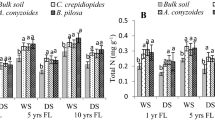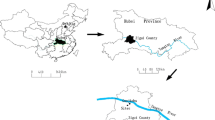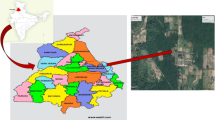Abstract
This study aims to understand rhizosphere effects on soil carbon (C) and nitrogen (N) differences of three annual plants (Crassocephalum crepidioides, Ageratum conyzoides and Bidens pilosa) in different fallow ages: 2 years (FP-2), 5 years (FP-5) and 10 years (FP-10) in Mizoram, northeast India. In 2 and 10 years fallows, dominant annual plants were A. conyzoides and B. pilosa respectively, however, in 5 years fallow; dominance equally shared among three species. The rhizosphere soil nutrients (organic carbon—SOC, total nitrogen—TN, microbial biomass C-MBC and N-MBN, NH4-N, NO3-N, N-mineralization rate—Nmin) were significantly (P < 0.05) greater in longer fallow compared to shorter fallow period. Rhizosphere soil of three annual plants showed 11–25%, 10–24%, 28–53% and 49–103% greater SOC, TN, MBC and MBN, respectively in FP-10 compared to FP-2. Similarly, 118–200%, 50–93%, 100–125% and 58–100% greater NO3-N, NH4-N, nitrification and Nmin rates were recorded in these stands. The concentrations of NH4-N, rates of nitrification and Nmin in rhizosphere soil were greater than bulk soil but the reverse was true in case of NO3-N. Difference between rhizosphere and bulk soil in the studied plants across fallow periods ranged from 17 to 63% in SOC, 27 to 64% in MBC, 21 to 70% in MBN, 52 to 80% in NH4-N and 25 to 67% in Nmin. The magnitude of rhizosphere effect of the three annual plants on soil C and N properties differed with fallow length. These results suggest that the microbial activity in rhizosphere soil is largely affected by the plant species and soil fertility level depending on fallow period. The differences in rhizosphere soil C and N largely depends on the soil fertility levels and the ability of the host plants to exploit resources.



Similar content being viewed by others
References
Bremner JM, Mulvaney CS (1982) Nitrogen—total, In: Page AL, Miller RL, Keeny DR (eds) Methods of soil analysis. Part-2 chemical and microbiological properties, 2nd edn. ASA, SSSA, CSSA, Madison, pp 595–613
Brookes PC, Joergensen RG (2006) Microbial biomass measurements by fumigation-extraction. In: Bloem J, Hopkins DW, Benedetti A (eds) Microbiological methods for assessing soil quality. CABI Publishing, Oxfordshire, pp 77–83
Bruun TB, de Neergaard A, Lawrence D, Ziegler AD (2009) Environmental consequences of the demise in swidden cultivation in Southeast Asia: carbon storage and soil quality. Hum Ecol 37:375–388
Colin-Belgrand M, Dambrine E, Bienaimé S, Nys C, Turpault MP (2003) Influence of tree roots on nitrogen mineralization. Scand J Forest Res 18:260–268
De Neergaard A, Magid J (2001) Influence of the rhizosphere on microbial biomass and recently formed organic matter. EurJ Soil Sci 52:377–384
El-Sheikh MA (2005) Plant succession on abandoned fields after 25 years of shifting cultivation in Assuit. Egypt J Arid Environ 61:461–481
Eno CF (1960) Nitrate production in the field by incubating the soil in polyethylene bags. Soil Sci Soc Am 24:277–279
Gobran GR, Clegg S, Courchesne F (1998) Rhizospheric processes influencing the biogeochemistry of forest ecosystems. In: Plant-induced changes: processes and feedbacks, vol 4, pp 107–120
Grogan P, Lalnunmawia F, Tripathi SK (2012) Shifting cultivation in steeply sloped regions: a review of management options and research priorities for Mizoram state, northeast India. Agrofor Syst 64:163–177
Hauchhum R, Tripathi SK (2017) Rhizosphere effects of Melocanna baccifera on soil microbial properties under different fallow phases following shifting cultivation. Int J Plant Soil Sci 17:1–9
Hauchhum R, Tripathi SK (2018) Impact of rhizosphere microbes of three early colonizing annual plants on improving soil fertility during vegetation establishment under different fallow periods following shifting cultivation. Agr Res. https://doi.org/10.1007/s40003-017-0286-2
Jackson ML (1958) Soil chemical analysis. Prentice Hall of India. Pvt. Ltd., New Delhi, pp 1–498
Jackson LE, Burger M, Cavagnaro TR (2008) Roots, nitrogen transformations, and ecosystem services. Annu Rev Plant Biol 59:341–363
Jenkinson DS, Brookes PC, Powlson DS (2004) Measuring soil microbial biomass. Soil Biol Biochem 36:5–7
Jones DL, Hodge A, Kuzyakov Y (2004) Tansley review: plant and mycorrhizal regulation of rhizodeposition. New Phytol 163:459–480
Jones DL, Nguyen C, Finlay RD (2009) Carbon flow in the rhizosphere: carbon trading at the soil root interface. Plant Soil 321:5–33
Kuzyakov Y, Friedel JK, Stahr K (2000) Review of mechanisms and quantification of priming effects. Soil Biol Biochem 32:1485–1498
Margalef DR (1958) Information theory in ecology. Gen Syst Yearb 3:36–71
Mueller-Dombois D, Ellenberg H (1974) Aims and methods of vegetation ecology. Wiley, New York
Phillips RP, Fahey TJ (2006) Tree species and mycorrhizal associations influence the magnitude of rhizosphere effects. Ecology 87:1302–1313
Pinton R, Veranini Z, Nannipieri P (2007) The rhizosphere: biochemistry and organic substances at the soil-plant interface. Taylor & Francis Group LLC, New York
Shannon CE, Weaver WW (1963) The mathematical theory of communication. University Illinois Press, Urbana
Singh SB, Mishra BP, Tripathi SK (2015) Recovery of plant diversity and soil nutrients during stand development in subtropical forests of Mizoram. Northeast India. Biodiversitas 16(2):205–212
Tanaka S, Ando T, Funakawa S, Sukhrun C, Kaewkhongkha T, Sakurai K (2001) Effect of burning on soil organic matter content and N mineralization under shifting cultivation system of Karen people in northern Thailand. Soil Sci Plant Nutr 47:547–558
Tripathi SK, Vanlalfakawma DC, Lalnunmawia F (2017) Shifting cultivation on steep slopes of Mizoram, India: impact of policy reforms. In: Cairns M (ed) Shifting cultivation policies: balancing environmental and social sustainability. CABI International, Wallingford, Oxfordshire, 393–413
Tscherko D, Ute H, Marie-Claude M, Ellen K (2004) Shifts in rhizosphere microbial communities and enzyme activity of Poa alpina across an alpine chronosequence. Soil Biol Biochem 36:1685–1698
Walkley A (1947) Critical examination of rapid method for determining organic carbon in soils, effect of variation in digestion conditions and of inorganic soil constituents. Soil Sci 632:251
Wang ZY, Göttlein A, Bartonek G (2001) Effects of growing roots of Norway spruce (Picea abies [L.] Karst.) and European beech (Fagus sylvatica L.) on rhizosphere soil solution chemistry. J Plant Nutr Soil Sci 164:35–41
Wang GL, Liu GB, Xu MX (2009) Above and belowground dynamics of plant community succession following abandonment of farmlands on the Loess Plateau, China. Plant Soil 316:227–239
Warembourg FR, Roumet C, Lafont F (2003) Differences in rhizosphere carbon partitioning among plant species of different families. Plant Soil 256:347–357
Wetzel RG, Likens GE (1979) Limnological analyses. W.B. Saunders Company, Philadelphia, pp 915–1156
Yanai RD, Majdi H, Park BB (2003) Measured and modelled differences in nutrient concentrations between rhizosphere and bulk soil in a Norway spruce stand. Plant Soil 257:133–142
Zhang C, Liu G, Xue S, Zhang C (2012) Rhizosphere soil microbial properties on abandoned croplands in the Loess Plateau, China during vegetation succession. Eur J Soil Biol 50:127–136
Zhao Q, Zeng DH, Fan ZP (2010) Nitrogen and phosphorus transformations in the rhizospheres of three tree species in a nutrient-poor sandy soil. Appl Soil Ecol 46:341–346
Acknowledgement
We thank University Grants Commission and Department of Biotechnology, New Delhi for financial support. We also thank farmers for providing lands and their heartfelt co-operation in completion of this work. Department of Forestry, Mizoram University is thankfully acknowledged for providing laboratory facility.
Author information
Authors and Affiliations
Corresponding author
Rights and permissions
About this article
Cite this article
Hauchhum, R., Tripathi, S.K. Carbon and nitrogen differences in rhizosphere soil of annual plants in abandoned lands following shifting agriculture in northeast India. Nutr Cycl Agroecosyst 113, 157–166 (2019). https://doi.org/10.1007/s10705-019-09972-5
Received:
Accepted:
Published:
Issue Date:
DOI: https://doi.org/10.1007/s10705-019-09972-5




